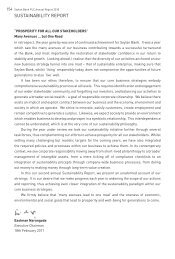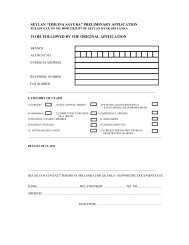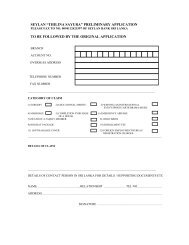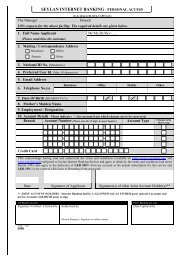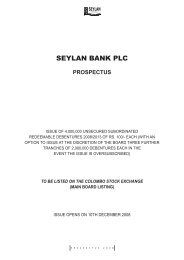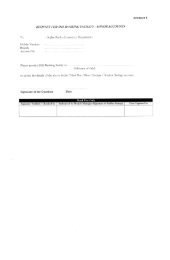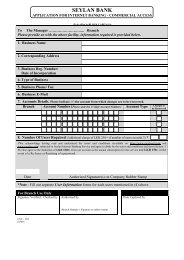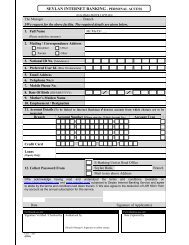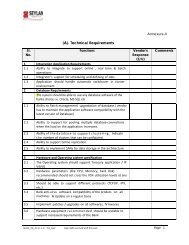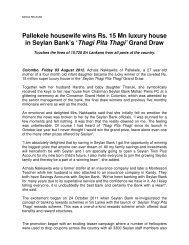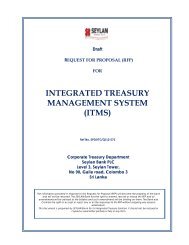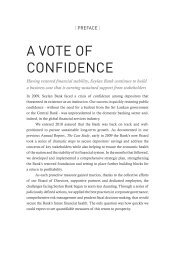The Case Study - Seylan Bank
The Case Study - Seylan Bank
The Case Study - Seylan Bank
Create successful ePaper yourself
Turn your PDF publications into a flip-book with our unique Google optimized e-Paper software.
158<strong>Seylan</strong> <strong>Bank</strong> PLC Annual Report 2009Notes to the Consolidated Financial Statementsterm liquid investment securities, loans and advances to banks and other inter-bank facilities, to ensurethat sufficient liquidity is maintained.All liquidity policies and procedures are subject to review and approval by ALCO. Daily reports cover theliquidity position of the <strong>Bank</strong>. A summary report, including any exceptions and remedial action taken, issubmitted regularly to ALCO.Exposure to Liquidity Risk<strong>The</strong> key measure used by the <strong>Bank</strong> for managing liquidity risk is the ratio of net liquid assets to depositsfrom customers. For this purpose net liquid assets are considered as including cash and cash equivalents.Liquidity Management 2009 2008 2009 2008Domestic Domestic<strong>Bank</strong>ing Unit <strong>Bank</strong>ing UnitForeignCurrency<strong>Bank</strong>ing UnitForeignCurrency<strong>Bank</strong>ing UnitAs at 31st December 28.80% 20.11% 24.94% 22.11%Highest 28.80% 22.70% 24.94% 22.72%Lowest 11.87% 20.09% 12.85% 20.25%Average 19.19% 21.55% 20.24% 21.33%(e) Market RisksMarket risk is the risk that changes in market prices, such as interest rates, equity prices, foreignexchange rates and credit spreads (not relating to changes in the obligor’s/issuer’s credit standing) willaffect the <strong>Bank</strong>’s income or the value of its holdings of financial instruments. <strong>The</strong> objective of marketrisk management is to manage and control market risk exposures within acceptable parameters, whileoptimising the trading portfolios for risk management purposes. Overall authority for market risk is vestedin ALCO.Market risk is the risk arising from fluctuations in the market price/value of tradable assets such asforeign exchange, fixed income securities and shares that are held for trading purposes where the <strong>Bank</strong>holds either long positions or short positions of such assets.<strong>The</strong> two risk components of the market risk most applicable to the <strong>Bank</strong> are foreign exchange risk andinterest rate risk.(e.I) <strong>The</strong> Foreign Exchange Risk arises from the foreign exchange positions maintained by the <strong>Bank</strong>where either the foreign currency denominated assets exceed such liabilities (long positions) or the foreigncurrency denominated liabilities exceed the assets (short positions). Such long or short positions could alsobe created through the sale or purchase transactions both in spot and forward markets as well as throughswap transactions. <strong>Bank</strong> is conservative and prudent in its management of foreign exchange exposures andhas set out limits on its transactions and exposures including dealer limits, portfolio limits, daylight limits,overnight limits, long position limits, short position limits, counter party limits, etc.(e.II) Interest Rate Risk arises from the movement of interest rates affecting the value of tradable fixedincome securities as well as the interest rate re-pricing gaps of the interest rate sensitive assets andliabilities. <strong>The</strong> <strong>Bank</strong> evaluates the risk level of the tradable fixed income securities portfolio by assessingthe sensitivity of the market value towards a change of interest rates by one hundred basis points, whichis one percentage point. <strong>The</strong> size and duration of the trading portfolio is capped based on the potentialrisk exposure as well as the board approved limits placed on absolute values. <strong>Bank</strong>s also typically have



